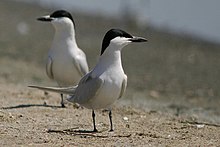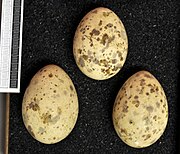Gull-billed tern
| Gull-billed tern | |
|---|---|

| |
| Scientific classification | |
| Domain: | Eukaryota |
| Kingdom: | Animalia |
| Phylum: | Chordata |
| Class: | Aves |
| Order: | Charadriiformes |
| Family: | Laridae |
| Genus: | Gelochelidon |
| Species: | G. nilotica
|
| Binomial name | |
| Gelochelidon nilotica (Gmelin, JF, 1789)
| |

| |
Year-round Breeding Nonbreeding
| |
| Synonyms | |
|
Sterna nilotica | |
The gull-billed tern (Gelochelidon nilotica), formerly Sterna nilotica, is a
Taxonomy
The gull-billed tern was
Five subspecies are recognised:[7]
- G. n. nilotica (Asia to western China & Thailand
- G. n. affinis (Horsfield, 1821) – found in Transbaikalia to Manchuria, Japan, south and east China through southeast Asia to the Philippines, Borneo, Sulawesi & Sumatra
- G. n. aranea (Wilson, 1814) – found in eastern & southern United States, Greater Antilles
- G. n. vanrossemi Bancroft, 1929 – found from southern California to northwestern Mexico
- G. n. gronvoldi Mathews, 1912 – found from French Guiana to northeastern Argentina
Description

This is a fairly large and powerful tern, similar in size and general appearance to a Sandwich tern, but the short thick gull-like bill, broad wings, long legs and robust body are distinctive. The summer adult has grey upperparts, white underparts, a black cap, strong black bill and black legs. The call is a characteristic ker-wik. It is 33–42 cm (13–17 in) in length and 76–91 cm (30–36 in) in wingspan.[10][11] Body mass ranges from 150–292 g (5.3–10.3 oz).[12]
In winter, the cap is lost, and there is a dark patch through the eye like a Forster's tern or a Mediterranean gull. Juvenile gull-billed terns have a fainter mask, but otherwise look much like winter adults.
Juvenile Sandwich terns have a short bill, and are frequently mistaken for gull-billed tern where the latter species is uncommon, such as North Sea coasts.
Distribution and habitat
It breeds in warmer parts of the world in southern Europe, temperate and eastern Asia, both coasts of North America, eastern South America. This bird has a number of geographical races, differing mainly in size and minor plumage details.
All forms show a post-breeding dispersal, but the northern breeders are most migratory, wintering south to Africa, the Caribbean and northern South America, southern Asia and New Zealand.
The gull-billed tern is one of the species to which the Agreement on the Conservation of African-Eurasian Migratory Waterbirds (
Behaviour and ecology
Breeding
The gull-billed tern breeds in colonies on lakes, marshes and coasts (including bays and earthen levees). It nests in a ground scrape and lays two to five eggs. While widely distributed in freshwater areas in Eurasia, it is associated almost solely with saltwater, coastal areas in North America.[10]
Food and feeding
This is a somewhat atypical tern, in appearance like a Sterna tern, but with feeding habits more like the Chlidonias marsh terns, black tern and white-winged tern. It does not normally plunge dive for fish like the other white terns, and has a broader diet than most other terns. It largely feeds on insects taken in flight, and also often hunts over wet fields and even in brushy areas, to take amphibians and small mammals.[10] It is also an opportunistic feeder, and has been observed to pick up and feed on dead dragonflies from the road.[13]
Gallery
-
Non-breeding inChilika, Odisha, India
-
Juvenile/ 1st winter in Chilika, Odisha, India
-
in Krishna Wildlife Sanctuary, Andhra Pradesh, India
-
van Rossem's gull-billed terns at the San Diego National Wildlife Refuge
References
- . Retrieved 6 December 2021.
- ^ Gmelin, Johann Friedrich (1789). Systema naturae per regna tria naturae : secundum classes, ordines, genera, species, cum characteribus, differentiis, synonymis, locis (in Latin). Vol. 1, Part 1 (13th ed.). Lipsiae [Leipzig]: Georg. Emanuel. Beer. p. 606.
- ^ Latham, John (1785). A General Synopsis of Birds. Vol. 3, Part 2. London: Printed for Leigh and Sotheby. p. 356, No. 8.
- Hasselquist, Fredrik (1757). Iter Palæstinum, eller Resa til Heliga Landet, förrättad ifrån år 1749 til 1752(in Swedish and Latin). Vol. 1757. Stockholm: Trykt på L. Salvii kåstnad. p. 273, No. 41.
- PMID 15804415.
- .
- ^ Rasmussen, Pamela, eds. (August 2022). "Noddies, gulls, terns, skimmers, skuas, auks". IOC World Bird List Version 12.2. International Ornithologists' Union. Retrieved 7 November 2022.
- ^ Brehm, Alfred (1830). "Beschluss der Uebersicht der deutschen Vögel". Isis von Oken (in German and Latin). 23. cols 985–1013 [994].
- ISBN 978-1-4081-2501-4.
- ^ a b c "Gull-billed Tern". All About Birds. Cornell Lab of Ornithology.
- ^ "Gull billed Tern (Gelochelidon nilotica)". Planet of Birds. 2011. Archived from the original on 2019-06-23. Retrieved 2011-10-20.
- ISBN 978-0-8493-4258-5.
- Newsletter for Ornithologists. 1 (1–2): 18–19.
External links
- BirdLife species factsheet for Gelochelidon nilotica
- "Gelochelidon nilotica". Avibase.
- "Gull-billed tern media". Internet Bird Collection.
- Gull-billed tern photo gallery at VIREO (Drexel University)
- Interactive range map of Gelochelidon nilotica at IUCN Red List maps
- Audio recordings of Gull-billed tern on Xeno-canto.
- Gelochelidon nilotica in Field Guide: Birds of the World on Flickr
- Gull-billed tern media from ARKive







